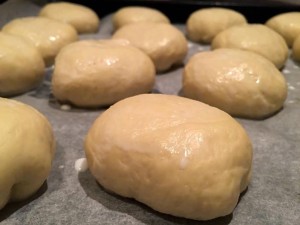Iris PalermitanePalermo Iris
L’antica ricetta utilizza dei panini, a forma di rosette, farciti con crema di ricotta che difficilmente si trovano nelle rosticcerie. In ogni caso, sia l’antica ricetta che quella più moderna costituiscono uno dei tipici “spuntini” siciliani che in palermitano stretto si chiamiamo “inis”.
Il matrimonio fra una pasta sofficissima fritta e un po’ granulosa, la crema di ricotta e la cioccolata fanno di questa squisitezza una delle pietre miliari delle ghiottonerie siciliane.

Ma perché questo nome, e dove nasce questa squisitezza?
La nascita di questa bontà risale al 1901, è in quell’anno, infatti, che al teatro Massimo di Palermo viene messa in scena la prima dell’opera di Mascagni “Iris”, è in questa occasione che il prestigioso pasticcere Antonino Lo Verso, insignito del titolo di “Cavaliere del Lavoro” da S.M.Vittorio Emanuele III, da vita alla sua ultima creazione in campo di pasticceria. Nasce così la Iris che da quel momento in poi diventa richiestissima dalla prestigiosa clientela che frequenta la sua caffetteria situata in via Roma. Il successo ottenuto da questa sua idea lo spinge a chiamare Iris anche il suo locale.

INGREDIENTI
500 grammi di farina 0
50 grammi di burro
30 grammi lievito di birra
Un pizzico di sale
3 uova
400 grammi ricotta di pecora
2,5 dl di latte
100 grammi cioccolato fondente a gocce
100 grammi di zuccata tagliata a piccoli dadini
400 grammi di zucchero
Pangrattato
Olio di semi per friggere
PROCEDIMENTO
Fare ammorbidire il burro. Mettere la ricotta con 250 grammi di zucchero in una ciotola abbastanza capiente e lavorarla con le fruste. Lasciarla riposare per circa mezz’ora, quindi aggiungere le gocce di cioccolato fondente, la zuccata e mettere da parte.
Setacciare la farina, unirvi il burro e iniziare a mescolare. Aggiungere all’impasto il lievito sminuzzato, 150 grammi di zucchero, il latte tiepido, poco alla volta, lavorandolo continuamente e infine un pizzico di sale. Non appena il composto sarà ben amalgamato, aggiungere un uovo battuto e continuare a lavorare l’impasto (se necessario, aggiungere poca acqua).
La pasta deve risultare morbida e la si deve lasciare coperta a lievitare per due ore, al caldo.
Trascorse le due ore, riprendere la pasta, stenderla con il mattarello e formare dei dischetti con un tagliapasta di circa 7 cm. ( o con il bordo di un bicchiere) dello spessore di circa un centimetro. Metter un cucchiaio di crema di ricotta sulla metà dei dischetti e ricoprirli con i dischetti rimasti, formando delle palle che andranno sistemate su un piano unto d’olio e lasciate lievitare per 1 ora in un luogo tiepido.
Infine passarle nelle uova battute con un pizzico di sale, poi nel pangrattato e friggerle in olio profondo fin quando non sono dorate.
Lasciarle su carta assorbente a perdere l’unto in eccesso e farle intiepidire.
L’antica ricetta prevede l’uso di panini, simili alle rosette, che vanno raschiate della crosta. Togliere un tondino dalla parte superiore del panino (che va conservato), quindi tramite il foro togliere parzialmente la mollica e inumidirle nel latte dolcificato. A questo punto farcirle con la crema di ricotta aiutandosi con una siringa a bocca larga attraverso il foro. Tappare il buco con il tondino messo da parte, infarinarle, passarle nelle uova sbattute con un pizzico di sale, poi nel pangrattato ed infine friggerle in olio profondo fin quando non sono dorate.
Lasciarle su carta assorbente a perdere l’unto in eccesso e farle intiepidire.
Oggi la Iris, o “Inis” come la chiamano i palermitani, è una morbida, croccante, squisita pasta sofficissima.
Chi volesse provare a realizzarla può anche utilizzare dei comuni panini al latte avendo cura di svuotarli di parte della mollica per fare posto alla farcitura.The ancient recipe uses some sandwiches in the shape of rosettes, stuffed with ricotta cream that are rarely found in takeaways. In any case, both the old recipe that the more modern form one of the typical Sicilians “snacks” who are called in Palermo dialect “inis”.The marriage between a spongy dough, fried and a bit grainy, the ricotta cream and chocolate make this delicacy one of the milestones of Sicilian delicacies.

But why this name, and where does this delicacy?
The birth of this goodness dates back to 1901, was in that year, in fact, that in the Palermo Massimo Theater is staging the premiere of Mascagni’s opera, “Iris”, it is on this occasion that the prestigious pastry chef Antonino Lo Verso, awarded the title of “Knight of Job” from H.M. Vittorio Emanuele III, born his latest creation in the field of pastry. Thus was born the Iris that from that moment onwards becomes in high demand by the prestigious guests who visit his café located in Via Roma. The success of this idea led him to call Iris also its local.

INGREDIENTS
500 grams of flour 0
50 grams of butter
30 grams beer yeast
A pinch of salt
3 eggs
400 grams of sheep ricotta
2.5 dl milk
100 grams dark chocolate drops
100 grams of candied pumpkin, cut into small cubes
400 grams of sugar
bread crumbs
Seed oil for frying
METHOD
Soften the butter. Put the ricotta with 250 grams of sugar in a fairly large bowl and knead with whips. Leave it for about half an hour, then add the chocolate drops, the candied pumpkin and set aside. Sift the flour, add the butter and start mixing. Add to the dough the chopped yeast, 150 grams of sugar, warm milk, little by little, working it all the time and finally add a pinch of salt. As soon as the mixture is well blended, add a beaten egg and continue to work the dough (if necessary, add a little water). The dough should be soft and you must leave covered to rise for two hours in a warm place. 
Elapsed the two hours, take the dough, roll it out with a rolling pin and form some discs with a cutter by about 7 cm. (Or with the edge of a glass) with a thickness of about one centimeter. Put a spoonful of cream cheese on half of the disks and cover with the remaining disks, forming balls that have to be placed on a greased surface oil and let rise for 1 hour in a warm place. Finally pass them in beaten egg with a pinch of salt, then in bread crumbs and fry in deep oil until they are golden. Leave them on paper towels to lose the excess oil and let them cool.
The ancient recipe calls for the use of buns, similar to the rosettes, which must be scraped off of the crust. Remove a rod from the top of the bun (which must be stored), then through the hole partially remove the soft part and moisten them in sweetened milk. At this point fill with the cream cheese with the help of a wide mouth syringe through the hole. Plug the hole with the rod pushed aside, flour, dip in beaten eggs with a pinch of salt, then in bread crumbs and finally fry in deep oil until they are golden. Leave them on paper towels to lose the excess oil and let them cool. Today, Iris, or “Inis” as they call the people of Palermo, is a soft, crunchy, delicious spongy pasta.
Anyone wishing to try out can also use the common milk buns making sure to empty them of part of the soft interior to make room for the filling.





Leave a comment